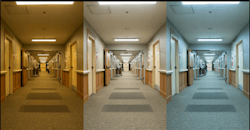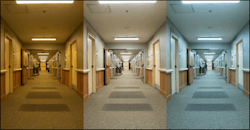Study Measures Light Exposure Effects on Nursing-Care Center Residents
LED technology offers the ability to tune spectral content and intensity. It is proposed that spectrally tunable and output-selectable LED lighting may improve dementia behaviors and sleep issues, which are common among residents of nursing-care centers. Some products propose to mimic the lighting color and intensity variations of daylight over the course of the day, with suggested benefits to circadian rhythm entrainment and health. But to date, most of the research on programmable, tunable LED lighting has had significant methodological limitations, did not use current lighting technology, or did not report enough detail about light and spectral exposure to be comparable to models of circadian health.
To address this, PNNL researchers conducted a study of tunable lighting at the ACC Care Center. The study involved a partnership between experts in lighting design, environmental design, and light measurement; experts in measuring resident behavioral outcomes in nursing centers; and leaders from a nursing center with previously installed programmable, tunable LED lighting. The objective was to test a strategy for measuring and documenting light exposure for typical nursing-center residents, and to evaluate the data in terms of various metrics for human circadian responses over the course of a day.
Three long-term-care corridors featured lighting settings that mimicked the facility’s former fluorescent lighting (static lighting) or that were programmed to change in spectrum and intensity (tuned lighting). The nighttime lighting mode had overhead LED lights delivering 2700 K (warm) ambient light, dimmed to 21% output. The spectrum was designed to minimize blue-cyan energy—the portion of the visible light spectrum most associated with human circadian melatonin levels and, as such, affects sleep quality and duration.
The daytime setting had 100% output at 6,500°K (cool), designed to maximize energy emitted in the blue-cyan range. A transition state between the nighttime and daytime settings had 4,100°K and 100% output.
The results show that residents experienced fewer nighttime sleep disturbances when their corridors were assigned to the tuned and dimmed lighting. Other findings center on lessons learned for care-facility operators, lighting designers, technology developers, and standards developers and recommendations for future research.
While the primary focus of this study was to establish feasibility and best-practice protocols for implementing tuned lighting in the nursing-home setting, results suggest that tuned lighting had a positive effect on residents’ sleep. The researchers were able to develop a methodology for collecting light-exposure data and analyzing those data using three different models for circadian health including circadian stimulus, melanopic/photopic ratios of the light received at the eye of the resident, and equivalent melanopic lux. This protocol will inform future studies on programming and evaluating tuned lighting systems in an institutional setting.
To learn more about the study, download the full report from the DOE.

